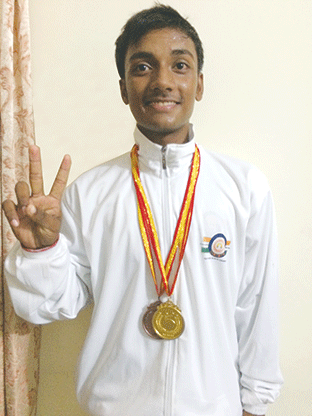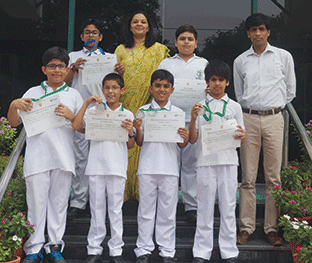 Undoubtedly to the surprise of his hosts, Lucknow-based kung fu martial arts practitioner Akash Yadav (17) bagged two gold medals in the Shaolinquan and soft weapon categories at the fourth World Kung Fu Championship 2015 held in Beijing (July 17-22). The championship attracted 10,000 contestants from 60 countries around the world.
Undoubtedly to the surprise of his hosts, Lucknow-based kung fu martial arts practitioner Akash Yadav (17) bagged two gold medals in the Shaolinquan and soft weapon categories at the fourth World Kung Fu Championship 2015 held in Beijing (July 17-22). The championship attracted 10,000 contestants from 60 countries around the world.
This youth’s astonishing feat is all the more notable since it’s been accomplished in a competitive sport the Chinese have promoted and dominated for centuries. Its origins can be traced back 1.7 million years to the hunting and defence needs of a primitive society.
Currently a privately schooled class XII state board student, Akash, the second of three siblings, was introduced to kung fu by his father Dev Narayan, owner of a small printing press whose own dream to learn this mental and physical fitness and martial sport remained unfulfilled. Interestingly, Akash began his formal training in kung fu in 2012 when his request to his former school (HAL School, Lucknow) principal to attend classes in self-defence, introduced for girl students only, was accepted.
In December 2013, Akash participated in the National Kung Fu Championship staged in Lucknow and bagged a silver. Shortly thereafter, he won two golds and a silver in the UP state championship. As a result, he was invited last year to the World Kung Fu Championship in Beijing. But he dropped out due to paucity of funds.
However, when the invitation was extended to him again in April this year, his homemaker mother Ranjana stepped forward and sold her jewellery to raise funds for his passage with family and friends also chipping in. Akash’s two golds in the Beijing World Championship vindicated their faith in his capabilities.
Although this kung fu master’s amazing feat received wide media coverage in China and the vernacular press in UP, the future looks bleak. “In India, kung fu is not popular enough to attract corporate sponsorship. Nevertheless, some local businessmen have evinced interest in sponsoring my training and participation in tournaments abroad. The Commission for Protection of Child Rights is also making a case for sponsorship with the state government,” says Akash, who is now studying intensively for his class XII board exams.
Given the grit and tenacity with which this young kung fu exponent has overcome all obstacles to travel to China and beat them in their own sport, something’s gotta give.
Puja Awasthi (Lucknow)
Robotics champs
In early june, two teams from Delhi Public School International, Pushp Vihar (Delhi) — comprising Ahaan Jain, Ayaan Khoshal, Raghav Tiwari and Shiv Verma (class VI), and Vansha Gupta and Md. Ismail (class VII) — were ranked #2 and #3 in separate categories in version 7.0 of the annual International Robotics Competition (IRC), conducted in Seattle by Building Blocks Pvt. Ltd (a Gurgaon-based educational company) in association with the University of Washington (UW). 
Launched last October IRC (India) 2014-15 attracted 1,500 school teams which competed in the zonal rounds across three categories — senior, middle and junior schools — of whom 120 qualified (40 in each category) for the national finals, convened in New Delhi on January 21. In the national finals, Vansha and Ismail (middle school category champs) earned an all-expenses paid trip to Seattle. But the four sixth graders (juniors) who bagged the ‘most innovative design’ award funded their own passage. Forty-five teams from five countries — India, China, Bangladesh, Maldives and the US — competed in the grand finale held in UW from June 2-9.
In Seattle, middle school teams were required to build a robot to replace human labour in a hypothetical diamond mine in Surat.
“We applied basic scientific concepts such as the pulley, dumper-truck, scissor lift and gear systems to design our robot,” says Vansha. Robots of competitors in the junior school category were required to lift miniature train coaches and place them on a staircase-like platform.
India’s top-ranked schools routinely promote the learning of robotics technology to develop students’ higher order thinking skills (HOTS) and help them grasp STEM (science, technology, engineering and mathematics) principles through application.
“In the long run, teaching robotics will tremendously benefit India’s economy as it helps eliminate labour drudgery and free up time for employees to improve productivity. We’ll be using robotics in whatever careers we choose,” says Vansha.
Wind in your sails!
Swati Roy (Delhi)